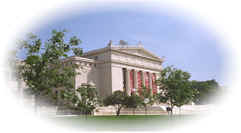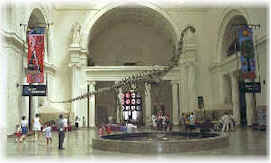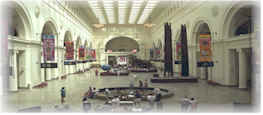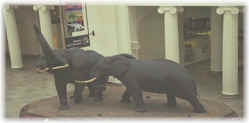AutomatedBuildings.com
Article - July 99
[Home Page] |
[an error occurred while processing this directive]
(Click Message to Learn More) |
|
|
 CHICAGO'S FIELD
MUSEUM CHICAGO'S FIELD
MUSEUM
by Michael Wilbourn
"How can we ensure that the capital
expenditures we are making today will serve the museums interest into the new millennium.
What technology exists that will carry us forward and not have us dependent on a sole
source as we currently are". new millennium.
What technology exists that will carry us forward and not have us dependent on a sole
source as we currently are". |
Michael
Wilbourn is Associate Vice President, Business Unit Manager Automatic Building Controls,
Inc. and the Chicago Representative for Alerton
Technologies Inc. |
 `The Field Museum is a cultural and historical archive serving not only to the
City of Chicago and its people but the world at large. Originally established in 1893 as
The Columbian Museum of Chicago, part of the Columbian Exposition, it was housed in The
Palace of Fine Arts Building in Jackson Park. Through the bequest of Marshall Field, The
Field Museum of Natural History was established at its present location.
`The Field Museum is a cultural and historical archive serving not only to the
City of Chicago and its people but the world at large. Originally established in 1893 as
The Columbian Museum of Chicago, part of the Columbian Exposition, it was housed in The
Palace of Fine Arts Building in Jackson Park. Through the bequest of Marshall Field, The
Field Museum of Natural History was established at its present location.
Constructed between 1915 and 1920, The Museum is one of the
few grand neoclassic buildings in the City of Chicago and houses the largest complete
fossil of the infamous Tyrannosaurus Rex, in the world. In 1973 the Museum had an
extensive architectural renovation followed by an exterior renovation in 1986. At present,
an upgrade of the mechanical infrastructure is ongoing under the direction of CATH
Associates. An integral part of this infrastructure is the Building Automation and Control
system. CATH reviewed numerous technologies and proposals and concluded that Alerton
Technologies' native BACnet product line, BACtalk, would best serve the Field Museums
current and future objectives.
In 1973 the Museum had an
extensive architectural renovation followed by an exterior renovation in 1986. At present,
an upgrade of the mechanical infrastructure is ongoing under the direction of CATH
Associates. An integral part of this infrastructure is the Building Automation and Control
system. CATH reviewed numerous technologies and proposals and concluded that Alerton
Technologies' native BACnet product line, BACtalk, would best serve the Field Museums
current and future objectives.
It was early in the design stage that the Museum, the
construction management, and the MEP team asked a very simple question. "How can we
ensure that the capital expenditures we are making today will serve the museums interest
into the new millennium. What technology exists that will carry us forward and not have us
dependent on a sole source as we currently are". The recommendation of McGuire
Engineers, the MEP consultant, and a bold one considering it was 1995, was to adopt the
new ASHRAE Standard 135-1995, BACnet.
[an error occurred while processing this directive]In early
1996, the Field Museum began work on Halls 6 & 7, the first of many projects on the
board. The design intent was to create an exhibit area that was both versatile in
capabilities and provided the environmental parameters demanded by curators whose
artifacts they bring to the public. Both objectives were met with an innovative
architectural design and a tightly integrated mechanical system utilizing Alertons BACtalk
technology.
 "The decision has worked for us", states Mr. John Mazza, Director,
Facility Planning and Operation. "We have been able to create a campus wide backbone
utilizing the BACnet architecture with Alertons native products. This architecture has
been installed over time as new projects were constructed. Today, we have a 10 base 2
network spanning the entire lower level of the museum. We have strategically located hubs
that allow integration of products from competing vendors with BACnet compliant devices.
The beauty is that we own the network and can dictate its use. We learned from past
experience that as an owner, you are buying proprietary networks and you sure can't
dictate their use".
"The decision has worked for us", states Mr. John Mazza, Director,
Facility Planning and Operation. "We have been able to create a campus wide backbone
utilizing the BACnet architecture with Alertons native products. This architecture has
been installed over time as new projects were constructed. Today, we have a 10 base 2
network spanning the entire lower level of the museum. We have strategically located hubs
that allow integration of products from competing vendors with BACnet compliant devices.
The beauty is that we own the network and can dictate its use. We learned from past
experience that as an owner, you are buying proprietary networks and you sure can't
dictate their use".
"We also anticipate that BACnet will allow us more
options in the future" interjects Mr. Ed Bogenski of CATH Associates. "The
BACnet protocol is nothing more that a set of rules on how data is defined and
transmitted. With deregulation around the corner, we see BACnet as a real time method for
procuring energy for the museum that will lower our cost. In addition, we are creating a
specification that specifically identifies BACnet as our protocol for manufactured
equipment. In the past, information was available at the equipment control panel but not
on the automation system without redundant sensors or expensive gateways. BACnet removes
these additional expenses and provides the museum with the manipulation of and the
information from the manufactured equipment through a simple tie-in to the network".
"Sometimes you just make the right decision" smiles
John.
Michael Wilbourn Associate Vice President,
Business Unit Manager Automatic Building Controls, Inc.
Chicago Representative for Alerton Technologies, Inc.
 CHICAGO'S FIELD
MUSEUM
CHICAGO'S FIELD
MUSEUM new millennium.
What technology exists that will carry us forward and not have us dependent on a sole
source as we currently are".
new millennium.
What technology exists that will carry us forward and not have us dependent on a sole
source as we currently are". `The Field Museum is a cultural and historical archive serving not only to the
City of Chicago and its people but the world at large. Originally established in 1893 as
The Columbian Museum of Chicago, part of the Columbian Exposition, it was housed in The
Palace of Fine Arts Building in Jackson Park. Through the bequest of Marshall Field, The
Field Museum of Natural History was established at its present location.
`The Field Museum is a cultural and historical archive serving not only to the
City of Chicago and its people but the world at large. Originally established in 1893 as
The Columbian Museum of Chicago, part of the Columbian Exposition, it was housed in The
Palace of Fine Arts Building in Jackson Park. Through the bequest of Marshall Field, The
Field Museum of Natural History was established at its present location.  In 1973 the Museum had an
extensive architectural renovation followed by an exterior renovation in 1986. At present,
an upgrade of the mechanical infrastructure is ongoing under the direction of CATH
Associates. An integral part of this infrastructure is the Building Automation and Control
system. CATH reviewed numerous technologies and proposals and concluded that Alerton
Technologies' native BACnet product line, BACtalk, would best serve the Field Museums
current and future objectives.
In 1973 the Museum had an
extensive architectural renovation followed by an exterior renovation in 1986. At present,
an upgrade of the mechanical infrastructure is ongoing under the direction of CATH
Associates. An integral part of this infrastructure is the Building Automation and Control
system. CATH reviewed numerous technologies and proposals and concluded that Alerton
Technologies' native BACnet product line, BACtalk, would best serve the Field Museums
current and future objectives.  "The decision has worked for us", states Mr. John Mazza, Director,
Facility Planning and Operation. "We have been able to create a campus wide backbone
utilizing the BACnet architecture with Alertons native products. This architecture has
been installed over time as new projects were constructed. Today, we have a 10 base 2
network spanning the entire lower level of the museum. We have strategically located hubs
that allow integration of products from competing vendors with BACnet compliant devices.
The beauty is that we own the network and can dictate its use. We learned from past
experience that as an owner, you are buying proprietary networks and you sure can't
dictate their use".
"The decision has worked for us", states Mr. John Mazza, Director,
Facility Planning and Operation. "We have been able to create a campus wide backbone
utilizing the BACnet architecture with Alertons native products. This architecture has
been installed over time as new projects were constructed. Today, we have a 10 base 2
network spanning the entire lower level of the museum. We have strategically located hubs
that allow integration of products from competing vendors with BACnet compliant devices.
The beauty is that we own the network and can dictate its use. We learned from past
experience that as an owner, you are buying proprietary networks and you sure can't
dictate their use". 